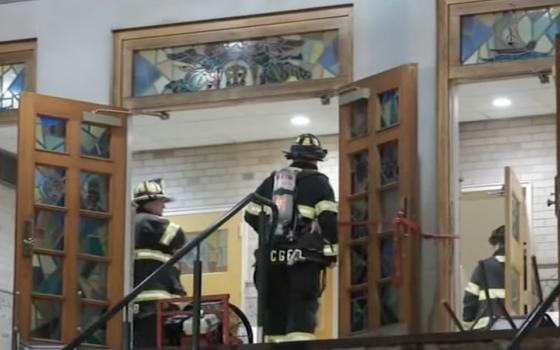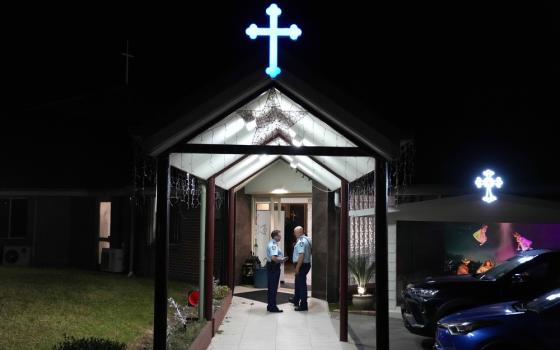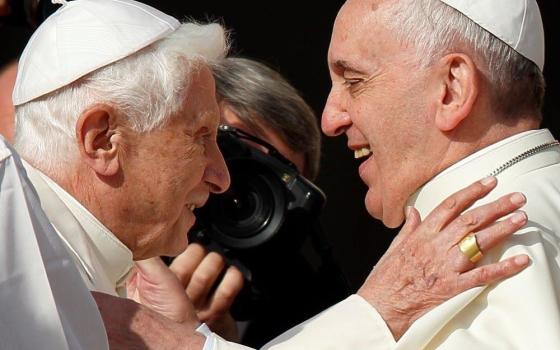This incident in the life of Jesus is one that is very familiar to us. We easily remember this event -- such an extraordinary happening at the very beginning of the public life of Jesus. As we listen to it, we could listen in kind of a superficial way and be aware, this would be true. Be aware that this was an example of how Jesus blessed the institution of marriage indicating it's something sacred, something very beautiful and important in life.
|
Second Sunday in Ordinary Time |
Also, it could show us clearly how Jesus is fully human. He would go to a party, a wedding feast, and celebrate with the people. Those two things are certainly true, but they're not really what this Gospel is about. They're at one level, kind of superficial. What this really is, as John says at the end of the passage, "This was the first of the signs." John, in his Gospel (and this is true throughout the Gospel) is not so much telling us a history of Jesus or giving us a biography of Jesus. He uses the events of Jesus to teach us about who Jesus is.
In this Gospel there are seven of what we call "signs," each one a kind of revelation -- Jesus is the Son of God. At the very end of the passage John tells us in this way, "Jesus made his glory known," who he is. If you're familiar with the Gospel of John, you might remember at the very beginning in what we call the "prologue" to John's Gospel (we heard it on Christmas Day, if you came to the Mass on that day), "In the beginning was the Word, and the Word was with God, and the Word was God…The Word was made flesh and dwelt among us. We have seen his glory, the glory of God's only Son, the fullness of truth and loving kindness."
"We have seen his glory," that's what John says in the prologue of his Gospel. Now in the Gospel, he begins to show us that through these signs, the same revelation of the glory that the Word of God who is God became flesh, entered into our world, began to transform this world through his teachings, through his love, and calls us to join in that.
There are a couple of other clues that you can look at in this Gospel lesson that show us that what John is talking about is more symbol than just literal truth. You notice (and I think probably most of us do because it's kind of jarring), when Mary comes to Jesus, he says, "Woman." He doesn't call her by name. He doesn't say, "Mother," or anything affectionate. There are only two times in the Gospel of John where Mary is present. In each instance Jesus says to Mary, "Woman."
The other time is at the crucifixion when Jesus looks from the cross and says to Mary, his mother, "Woman, behold your son," showing Mary as the mother of the community of disciples of Jesus. The son who was present at the cross was John. "John, behold your mother." In both cases, Mary is not being spoken of as we would think, in human terms as the mother of Jesus, but rather as a symbol of the community of disciples of Jesus. She is the mother of that community.
So Jesus uses a more generic way of addressing her. But the other thing that might call our attention to the fact that this whole incident is more symbolic than literal would be the fact that John says, "After three days, Jesus goes to Cana." What's that a reference to? Actually, it's a reference to the Book of Exodus where the Jewish people, released from Egypt, traveling through the desert come to Sinai and are gathered there. After three days God appears to them, "I will be your God, and you will be my people." The first covenant between God and the Chosen people is established.
Now, in John's Gospel we're being told this new covenant is being established. After three days -- now Jesus becomes like the new Moses and Jesus becomes the founder of the community of disciples -- the new people of God of whom we are all members. This Gospel lesson reminds us that Jesus is being manifested before the eyes of the people, and once more before our eyes, in our awareness Jesus has made very clear that he is Son of God in power. His glory is being manifested.
In this lesson, as you can tell, is a very clear fulfillment of what Isaiah had proclaimed in our first lesson where God is spoken of as the spouse to the people. "As a young man marries a virgin, so will your Builder marry you; as a bridegroom rejoices in his bride, so will your God rejoice in you." We are God's people. God rejoices in us. Jesus is the one who becomes the spouse of God's people, the very deep relationship of love -- unbreakable, faithful, unlimited, unconditional.
That's the relationship between God and us. Then among us, we try to share the same kind of love. There's a very deep meaning in this incident of the wedding at Cana. But also, if we connect it with that passage from the Book of Isaiah, we can see in this passage something that can give us hope. That passage from Isaiah was proclaimed at a time, as I said before, when the Chosen people had been driven into exile, their land had been destroyed, and their temple was in ruins. Everything seemed lost.
Yet, Isaiah proclaims this word of hope, "The glory of God will be revealed as you are restored to your home, as your temple is rebuilt, as you come back." When Isaiah said that, there was no clear indication that it was happening. He could trust in God's faithfulness as the spouse of God's people. Our lesson today from the Gospel can remind us once more that the glory of God is revealed in Jesus. Just as God was present to the people, restored them to the fullness of life, so Jesus has come into our midst.
We live in a world where we need the message of Jesus, where we need hope. When we look around at what is happening in our world, maybe especially in the Middle East -- the territory where Jesus lived, we see the same desolation, maybe even worse than what's happening back in the time of Isaiah, the time when God brought the people back and gave them hope. We can have that same hope because the glory of God is revealed in Jesus.
I think it's really the only thing that gives us genuine hope that somehow out of violence, hatred, death, and destruction can come new life. But there's one thing that is really necessary to make that hope become a reality, where our world will be transformed from violence, hatred, and war into peace -- to do what Mary did: Go to Jesus, bring your concerns to him, but then, remember what she said? "Do what he says." That's what we have to try to do now.
We're beginning a new year in the cycle of the church's celebrations of the life of Jesus. Each Sunday, if we really came to church and listened deeply to the Word of God, then began to act on it, bringing to Jesus our concerns, but then listening to what he tells us, transforming our lives, changing them so that his work of transforming the world will begin to happen more completely through us. Throughout this year, this new church year, as we listen each Sunday to God's Word, we can bring our concerns to Jesus and trust that if we do what he says, our hopes for peace and fullness of life and the transformation of our world will begin to happen before our very eyes.
[Homily given at St. Philomena Parish, Detroit. The transcripts of Bishop Gumbleton's homilies are posted weekly to NCRonline.org. Sign up here to receive an email alert when the latest homily is posted.]




